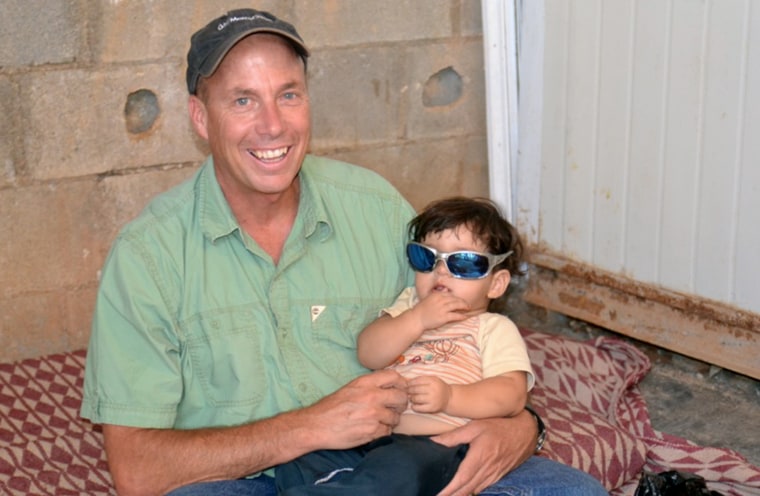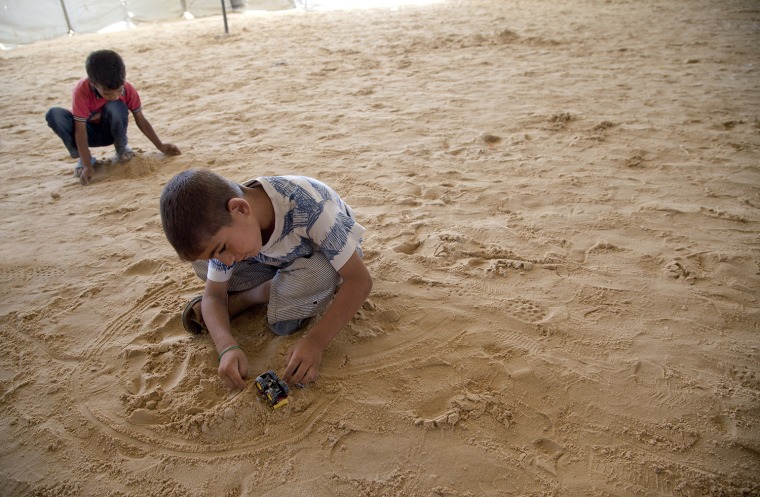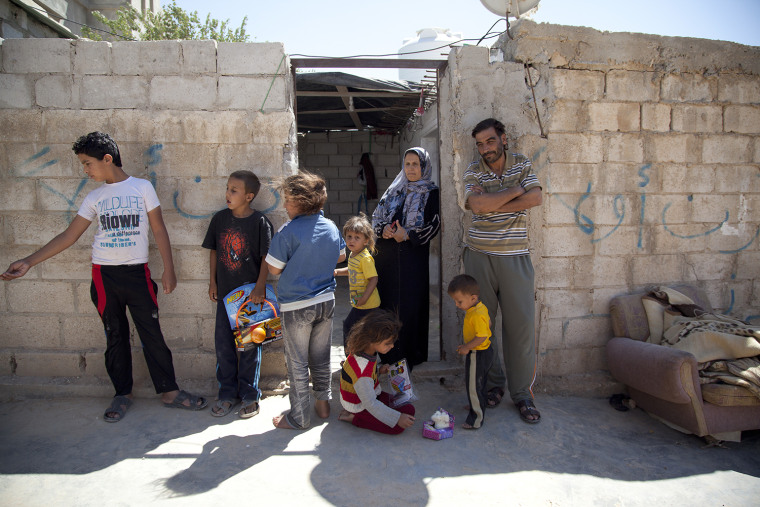
When aid worker Robert Maroni drives to the Zaatari refugee camp in northern Jordan, he knows to expect a sea of Syrian children. There are nearly 50,000 of them, after all.
But one day recently, it was an 18-month-old girl who caught his attention. Her searching eyes stood out from the chaos. His parental instincts kicked in, and he knew that she needed to be held, like so many of the children here.
Maroni met the little girl when he stopped to talk to her father, who had three other children between the ages of 1 and 8. This man was big, strong, and stoic — a member of the Syrian army who escaped. They sat in a small trailer and talked about the possibility of a U.S. airstrike to destroy the Syrian government’s alleged cache of chemical weapons.
Maroni paused to call the girl over. When he picked her up, she pressed her head against Maroni’s chest and sat calmly for the next hour.
“With such hardship, people forget little kids need to be picked up and held,” said Maroni, who has two daughters of his own. “This little girl really needed someone to hold her. You see that quite a bit.”
Such is life for the two million refugees who have left Syria since the civil war began in 2011 and the four million-plus who remain displaced within their native country. Those who fled sought safety in Jordan, Lebanon, Egypt, Iraq and Turkey; three-quarters of refugees are women and children. Aid workers commonly say that they arrive with nothing but the clothes on their backs.

More: Resources for helping Syrian refugees
The children and adults at Zaatari escaped the civil war in Syria and came to this camp, which was built out of the desert a year ago. Before they arrived, there was not a single structure, Maroni said. Now there are tents, trailers, playgrounds, hospitals, schools and makeshift market stalls for this small city of 120,000 refugees.
Maroni works for the international aid organization Mercy Corps and oversees 80 full-time staff and 10 projects in Jordan. The job comes with big decisions and duties, but perhaps nothing leaves more of an impression on him than the children.
Some are orphans, while others lost just one parent. Some have seen unspeakable acts of war, and others know only that something is terribly, perhaps irrevocably wrong. Maroni believes all of them need some measure of comfort and normalcy. There are carefree moments, like when the children gather in a large tent to watch the cat-and-mouse cartoon "Tom and Jerry" — it’s their favorite, Maroni said. And there is always a reminder of new beginnings as the camp sees multiple births each day.

That’s why Mercy Corps and other non-governmental organizations are working to provide them with basic essentials like shelter, water, food, supplies and medicine in addition to creating safe spaces for children to learn and play. Despite their efforts, there remains a tremendous need, particularly as more Syrians leave the country.
The United Nations Refugee Agency has called for $3 billion for the humanitarian crisis, but only 40 percent of the aid has been delivered so far. Host countries are finding it increasingly difficult to deliver the necessary services to refugees, according to aid workers who spoke to TODAY.com.
Mercy Corps said that it has received just over $1 million in donations from private individuals over the past two years. That pales, however, to the $8 million it raised in two months for survivors of the 2005 earthquake in Kashmir. The organization uses that comparison because roughly the same number of people — 100,000 — have died in the Syrian civil war as in the earthquake.
Doctors Without Borders, which provides medical services and support within Syria and at refugee camps, is also facing a significant shortfall. It is planning to spend $60 million to pay for staff salaries and materials for hospitals and facilities, but has only raised a third of that amount. It does not accept money from governments to ensure that it is perceived as an impartial party in the countries where it works.
“Cash support is absolutely key,” said Sophie Delaunay, executive director of Doctors Without Borders. She told TODAY.com that financial aid enables the organization to perform surgery and offer vaccinations, for example. Its staff monitors camp conditions, including disease outbreaks, high death rates and water availability. It also supplied doses of atropine, which is used for exposure to toxic agents.
During the recent attack in the Damascus suburbs — which the U.S. has called a chemical warfare assault — medical staff used their atropine supply. Doctors Without Borders is sending an additional 15,000 vials of the drug to Damascus-area facilities.
The Foundation to Restore Equality and Education in Syria (FREE-Syria), a 501(c)(3) non profit based in Virginia, is one of the few groups known publicly to work in Syria; some organizations don’t want their role disclosed for security reasons.
Rafif Jouejati, a director of FREE-Syria, said the organization partners with an activist network known as the Local Coordinating Committees of Syria to deliver food baskets to hungry families, sponsoring orphaned children to live with adoptive families, and founding schools in available facilities, including warehouses, garages and apartments. FREE-Syria has also led an effort to create “safe zones” for women in refugee camps.
Jouejati, a Syrian American, said that every bit of financial support is vital: “If you can help five or 10 people then you have done something. And if every one of us does that, then we help a village.”
Though the aid organizations stress that cash donations are critical and easier to use, Mercy Corps was grateful to recently receive 11,000 toys and games from Hasbro, which included stuffed animals, plastic trucks and action figurines.
Maroni instantly noticed the benefit of the gift. “It gives them an opportunity to use their imagination and play like little kids,” he said.
Such reprieves are essential for both the children and the aid workers, but there is much more to be done. Families who have opted to live in ramshackle houses instead of the refugee camp need repairs and improvements before winter comes, and Mercy Corps will perform these services if landlords agree not to increase already expensive rents.
A new refugee camp, Azraq, is slated to open in Jordan soon, and it will be a place where children can learn how to use a computer or play musical instruments, and receive more intensive psychological and social support.
That last type of assistance can really help steady kids who are struggling. When possible, Mercy Corps holds sessions for refugee children to meet peers in their host country. They might gather in a circle and throw a ball back and forth, saying a child’s name as an introduction — and a step to a new friendship.
Traumatized kids are frequently provided with a drawing workbook and are asked to illustrate their family. Some draw figures in vivid color whereas others in the image look like ghosts. The young artists explain that the sickly characters are dead or disappeared.
With no end in sight for the civil war, Maroni and his colleagues are preparing to travel a very long road.
As for keeping the children in good spirits, Maroni said the priority is to engage and support them.
“You do the best you can,” he said.